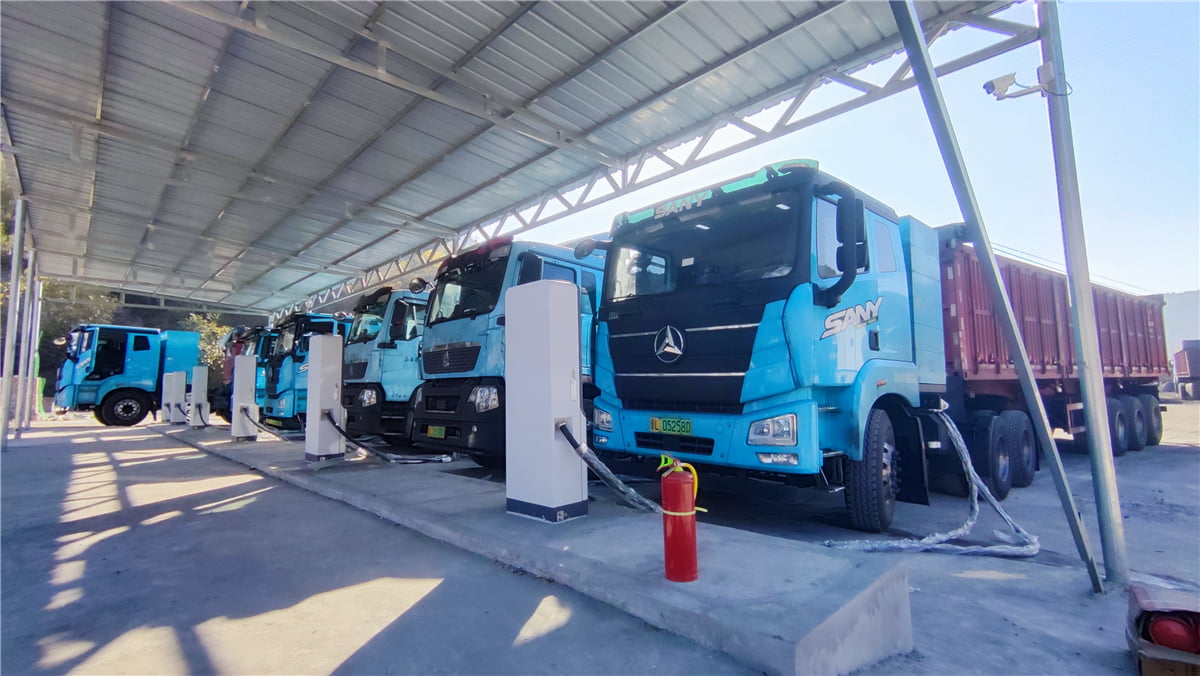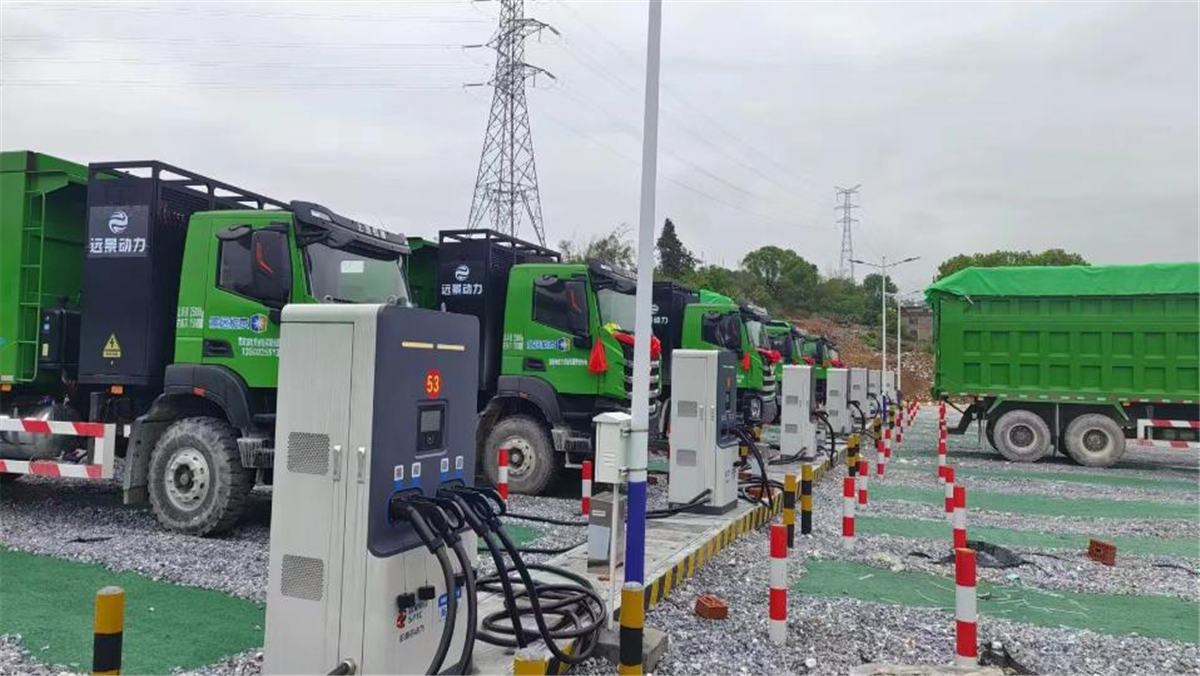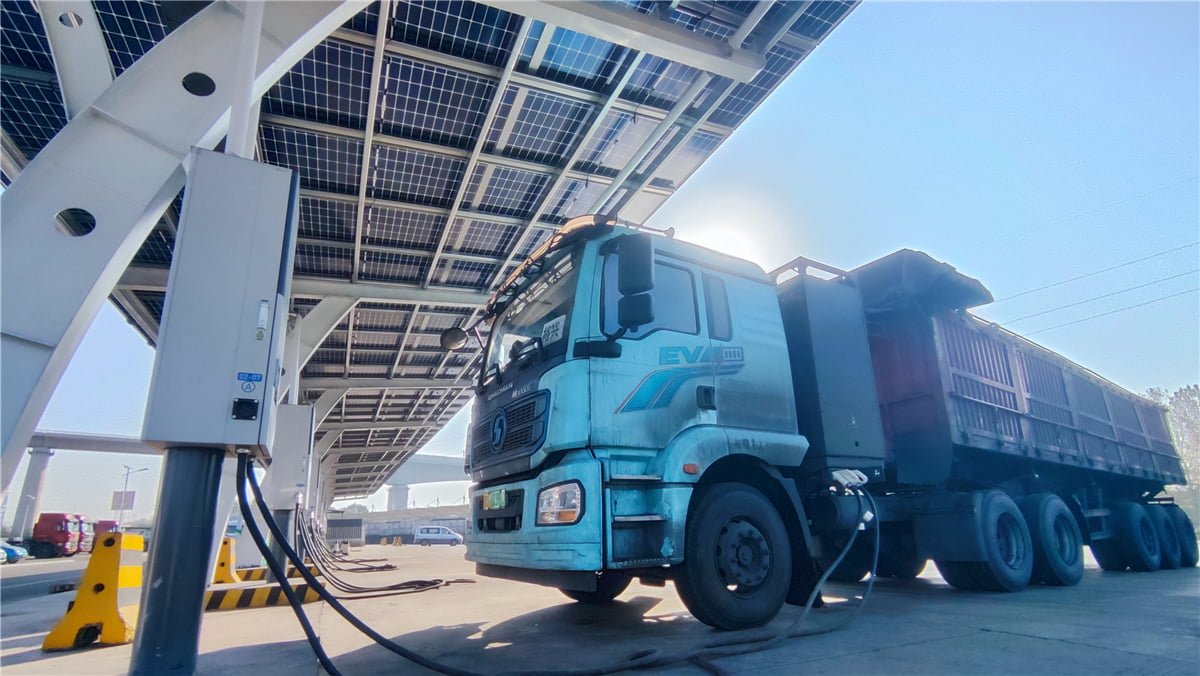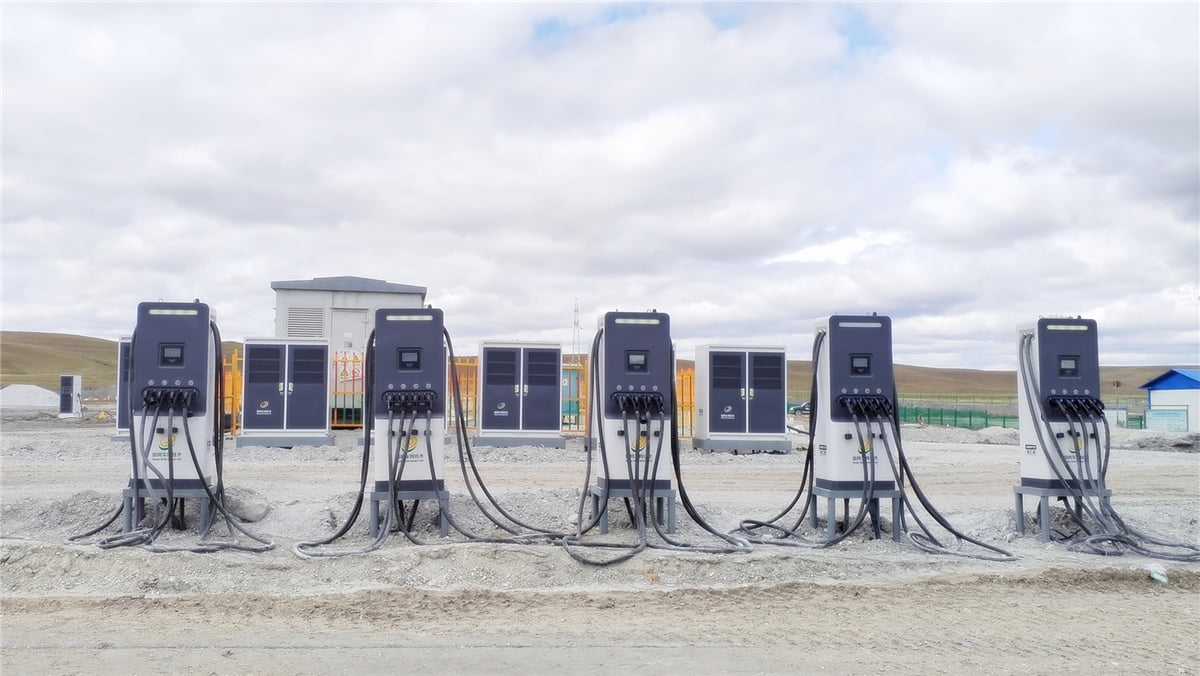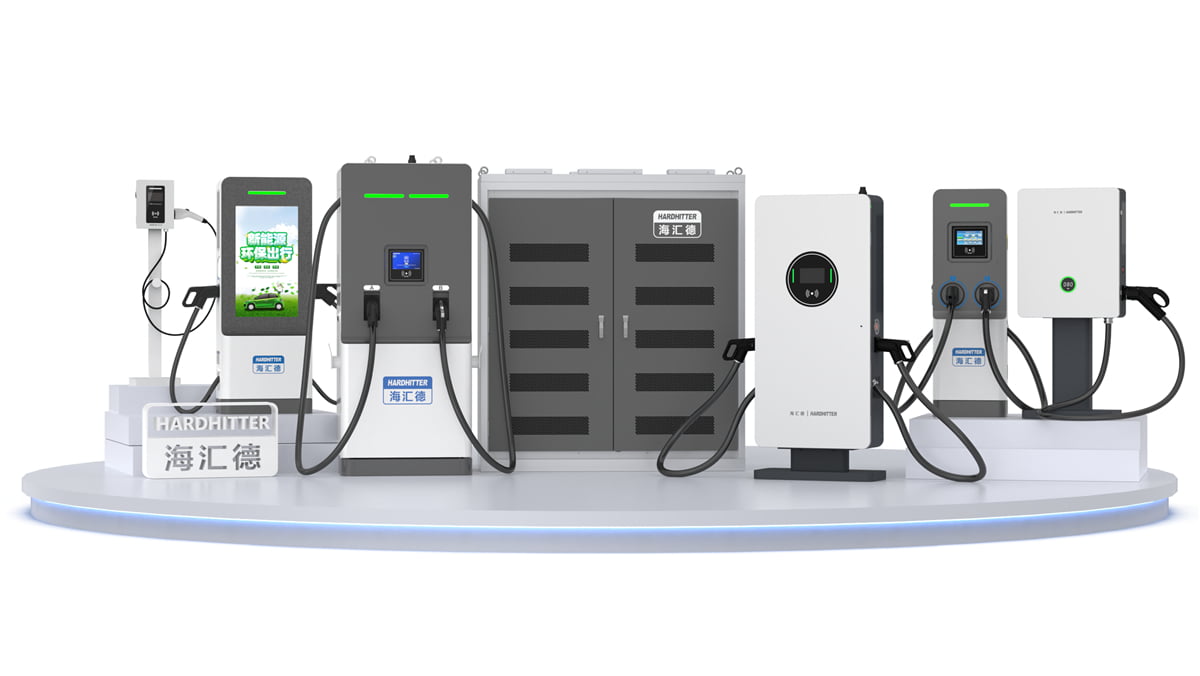HARDHITTER | The Process of Building a Heavy Truck Charging
Station: A Detailed Guide and Experience Sharing from
Planning to Construction
In the current era of rapid development of new energy,
the ownership and penetration rate of electric heavy
trucks are continuously increasing, and the energy
supply mode is undergoing changes, leading to a
significant increase in the demand for heavy truck
charging stations.
Building a heavy truck charging station involves
multiple links and professional fields. Each step, from
planning, construction to operation, is crucial. The
following is a guide to the process of building a heavy
truck charging station, incorporating the experience and
suggestions of HARDHITTER, hoping to provide ideas and
useful references for your station building process.
I. Preliminary Planning and Research
1、Market Demand Analysis
The first step is to understand the local heavy truck
ownership . For example, the working hours of mining
heavy trucks are relatively fixed, but they have short
charging intervals and a large demand for centralized
charging; the operation routes of logistics transport
heavy trucks are complex, and charging facilities may be
required along the way and at the destination.
By communicating with local logistics enterprises,
mining enterprises, transport fleets, etc., collect
usage information of heavy trucks, such as mileage,
operation time, parking duration, etc. At the same time,
combined with the local economic development trend and
industrial planning, predict the future growth of the
number of heavy trucks to evaluate the potential
charging demand. Scientifically determine the scale and
service capacity of the charging station to avoid
over-construction or insufficient capacity.
2. Site Selection Evaluation
Traffic Convenience:
It is of utmost importance to select a site close to
highway entrances and exits, intersections of national
and provincial roads, or large logistics parks, ports,
mines and other areas where heavy trucks are intensively
operated. When evaluating traffic convenience, some
specific data can more intuitively reflect the
advantages of the site selection.
Generally speaking, a distance within 5 kilometers from
the highway entrance and exit is an ideal range, so that
heavy trucks can reach the charging station in a short
time after getting off the highway, reducing the empty
driving time and power consumption of vehicles on the
road.
For the site selection of national and provincial roads,
the distance between the charging station and the road
should not exceed 2 - 3 kilometers, and the average
speed of the surrounding roads during peak hours should
not be less than 30 kilometers per hour to ensure that
heavy trucks entering and leaving the charging station
will not cause traffic congestion.
If it is near a logistics park, the straight-line
distance between the charging station and the main
entrance and exit of the park is preferably controlled
within 1 - 2 kilometers to ensure sufficient buffer
space and traffic capacity.
For the site selection around the port, the traffic
capacity of the internal roads of the port should be
considered. Generally, the designed traffic capacity of
the main roads of the port should be able to meet the
flow of at least 100 heavy trucks per hour, and the
distance between the charging station and the loading
and unloading area of the port should not exceed 3 - 5
kilometers, which is convenient for heavy trucks to
charge during the loading and unloading of goods.
In addition, pay attention to the smoothness of the
surrounding traffic and avoid traffic congestion caused
by vehicles entering and leaving the charging station.
You can observe the traffic flow and traffic conditions
of the surrounding roads during peak hours on the spot
and select a location with sufficient buffer space.
Power Supply Conditions:
Communicate with the local power department. Investigate
the capacity and stability of the existing power grid
and understand the future upgrade plan of the power
grid. For heavy truck charging stations with large power
consumption, dedicated line power supply may need to be
considered.
During the initial stage of site selection, evaluate the
feasibility of power access at the alternative sites.
Pay attention to the price policy of the local power
supply. Different regions and power supply methods may
have large cost differences, which have an important
impact on the long-term operating cost of the charging
station.
Land Resources:
According to the planned scale of the charging station,
find a suitable area of land. The nature of the land
must meet the construction requirements. Priority is
given to industrial land or construction land that meets
the planning. Consider the service life of the land and
try to choose a long-term and stable lease or purchase
method to avoid affecting the continuous operation of
the charging station due to land problems.
When evaluating the land cost, in addition to the rent
or purchase price, also consider the possible costs such
as land leveling and supporting infrastructure around
the land. In addition, you can pay attention to the
local government's industrial park planning or land
preferential policies and strive to obtain more
favorable construction conditions.
II. Project Approval and Filing
1、Project Initiation
Writing a project feasibility study report is a
systematic project. When elaborating on the necessity of
project construction, in addition to market demand
analysis, it is also necessary to combine the national
and local new energy development strategies and
environmental protection policies to highlight the
positive significance of the heavy truck charging
station for regional sustainable development.
In the technical scheme part, describe the charging
equipment selection, layout planning, power supply
system design and other contents. For economic
evaluation, consider construction costs, operating
costs, revenue forecasts, etc., including details such
as equipment depreciation, personnel wages, electricity
costs, and charging service fee income.
When applying for project initiation to the relevant
government departments, ensure that the report content
is detailed and the data is accurate, and actively
communicate with the approval department to answer the
questions they may raise.
2、Planning Approval
When submitting the planning and design scheme of the
charging station to the local planning department, in
addition to meeting the basic building and layout
specifications, also pay attention to the coordination
with the surrounding environment.
When planning the charging area, consider factors such
as the turning radius and parking spacing of heavy
trucks to ensure the convenience and safety of vehicle
charging operations. If it affects the surrounding
traffic, it is necessary to provide the corresponding
traffic organization scheme, such as the design of
vehicle entry and exit routes and parking guidance
signs.
3、Power Access Approval
Submit a power access application to the power supply
department. The detailed calculation of power load and
the basis for selecting the access point are very
important. In addition to the expected simultaneous
usage rate of charging equipment and the maximum power
demand, etc., also consider the future expansion demand.
When negotiating the access scheme with the power
department, you can ask whether there is the possibility
of smart grid access, which helps to improve the power
management efficiency and stability of the charging
station. Understand the procedures and time nodes for
handling the power access process and prepare the
relevant materials in advance to avoid delaying the
project progress due to formalities.
III. Equipment Selection and Procurement
1、Charging Equipment
Heavy truck charging requires high power, and DC fast
charging equipment is the mainstream choice. However,
when selecting a specific model, it should be determined
according to the battery type, capacity of the heavy
truck and the charging time requirements of the
operating enterprise. For example, for some new heavy
trucks with large battery capacity, charging equipment
with a power of more than 300kW may need to be selected.
The compatibility of the equipment is crucial. It is
necessary to ensure that it can be compatible with the
charging interfaces and communication protocols of
various mainstream heavy truck models on the market.
In terms of safety, select equipment with multiple
protection functions, such as overvoltage, overcurrent,
and leakage protection, and it must comply with relevant
international and domestic safety standards.
The degree of intelligence is also a consideration
factor. Charging equipment with an intelligent power
scheduling system can automatically adjust the charging
power according to the power grid load and the vehicle
battery state, improving the charging efficiency and
power grid stability.
It is recommended to test different brands and models of
charging equipment before procurement or refer to the
usage of the equipment in existing charging stations.
2、Auxiliary Equipment
Transformer:
Select an energy-efficient transformer with an
appropriate capacity according to the total power
consumption and peak power load, and reserve capacity
redundancy.
Distribution Cabinet:
The design should be reasonable, able to clearly
distribute power, have overload and short-circuit
protection functions, be easy to operate and maintain,
and a distribution cabinet with an intelligent
electricity meter and monitoring function can be
selected.
Monitoring System:
It should have strong compatibility, stable and reliable
data transmission, be easy to operate and maintain, and
can real-time monitor the charging status, equipment
operation status and environmental parameters and other
information.
Fire-fighting Equipment:
In addition to conventional fire extinguishers and fire
hydrants, consider installing an automatic fire alarm
system and an automatic fire extinguishing system, and
configure them reasonably according to the layout of the
charging station and the distribution of equipment.
IV. Charging Station Construction
1、Infrastructure Construction
Site Leveling:
Use measuring instruments to measure the flatness and
slope of the site (the flatness error is within ±5 cm),
and use mechanical equipment for leveling. If there is a
problem of water accumulation, design a drainage slope
(not less than 0.3% - 0.5%) to ensure that rainwater can
be smoothly drained out of the site and avoid affecting
the normal use of charging equipment and vehicles due to
rainwater accumulation.
Building Construction:
Charging Shed:
Consider the local climate conditions. The height of the
shed roof should not be less than 4.5 meters. Use a
steel structure with a yield strength of not less than
235MPa to build the frame. The shed roof material can be
selected from 0.4 - 0.6 mm thick color steel plate or 6
- 10 mm thick sunlight panel, which can be selected
according to actual needs and budget.
Management Room:
The building area is determined according to the number
of operating personnel and functional requirements (for
example, for 5 - 8 people, the area is 80 - 120 square
meters).
Cable Trench Excavation:
Excavate according to the design requirements. The depth
is generally between 0.8 - 1.2 meters, and the width is
between 0.4 - 0.6 meters. Lay a 10 - 15 cm thick layer
of fine sand as the cushion layer in the trench. After
the cable is laid, cover another layer, and finally seal
it with a cement cover plate or red brick.
2、Equipment Installation and Commissioning
Equipment Installation:
It should be installed by professional electrical
technicians according to the equipment installation
instructions.
Determine the installation position of the equipment to
ensure that there is sufficient safety distance between
the equipment and surrounding objects. For example, the
distance between the charging equipment and the wall
should not be less than 1 meter, and the distance
between it and other equipment should not be less than
0.8 meters to ensure the heat dissipation and
maintenance space of the equipment during operation.
For the fixed installation of the equipment, use
expansion bolts or anchor bolts to fix the equipment on
the ground or foundation platform. The specification of
the bolts should be determined according to the weight
and installation requirements of the equipment. For
example, for charging equipment weighing 500 - 1000
kilograms, generally use M16 - M20 expansion bolts.
When installing the distribution cabinet, place the
distribution cabinet in the appropriate position
according to the design drawings to ensure a reasonable
electrical connection distance between the distribution
cabinet and other equipment, which is convenient for
operation and maintenance. The foundation height of the
distribution cabinet is generally between 0.2 - 0.4
meters to avoid the influence of ground humidity on the
distribution cabinet.
For a medium-sized charging station, install 1 - 2
cameras per 100 - 200 square meters of area, with a
height of 2.5 - 3.5 meters.
Single-machine Commissioning:
Commission each charging equipment to check whether the
working voltage and current are normal. Generally
speaking, the output voltage error of the charging
equipment should be within ±5%, and the current error
should be within ±10%.
Commission the distribution cabinet to check whether the
overload protection, short-circuit protection and other
functions are normal.
Commission the monitoring equipment to check whether the
image transmission of the monitoring equipment is clear
and whether the data collection is accurate.
On-line Commissioning:
After the single-machine commissioning is completed,
conduct on-line commissioning. Simulate the heavy truck
charging process to test whether the charging function,
power distribution, monitoring data transmission and
other functions of the entire charging station system
are normal.
Check the cooperative working capability between
charging devices For example, when multiple charging
equipment charges a heavy truck at the same time,
whether the power can be reasonably allocated to meet
the charging needs of the heavy truck.
Check whether the communication between the monitoring
system and the charging equipment is normal and whether
the monitoring system can real-time obtain the working
status and charging data of the charging equipment.
V. Operation Preparation and Acceptance
1、Personnel Training
Conduct training for operation and management personnel
on charging equipment operation (start, stop, charging
mode selection, fault handling), safety management
(electrical, fire-fighting, emergency escape knowledge),
and customer service (communication skills, complaint
handling). You can invite technical experts from
equipment suppliers and professional training
institutions for training and conduct assessment after
the training.
2、Operation Preparation
Formulate detailed and operable operation management
systems. The charging standard should comprehensively
consider the cost and market conditions and comply with
the price regulations. The business hours should be
determined according to the local heavy truck operation
time. Formulate emergency response plans (for equipment,
power failures and safety accidents), and prepare
operation materials such as a charging card management
system and an invoice printer.
3、Acceptance
Organize relevant departments and experts for
acceptance, including engineering quality (the building
structure and charging facility installation meet the
design and construction standards), equipment
performance (the performance of charging, monitoring,
and fire-fighting equipment meets the standards), and
safety facilities (fire-fighting passages, fire-fighting
equipment, electrical safety measures) acceptance.
Actively cooperate and timely rectify the problems.
Building a heavy truck charging station is a complex and
systematic project that requires careful planning,
strict construction and full preparation. Each link is
interrelated and influential, and any negligence of
details may affect the overall performance and operation
effect of the charging station.
We hope that the above content can provide strong
guidance for you in the process of building a heavy
truck charging station and jointly promote the vigorous
development of the new energy heavy truck industry.
If you want to know more detailed station building
processes and charging pile product information, please
follow us and leave a message for consultation.
